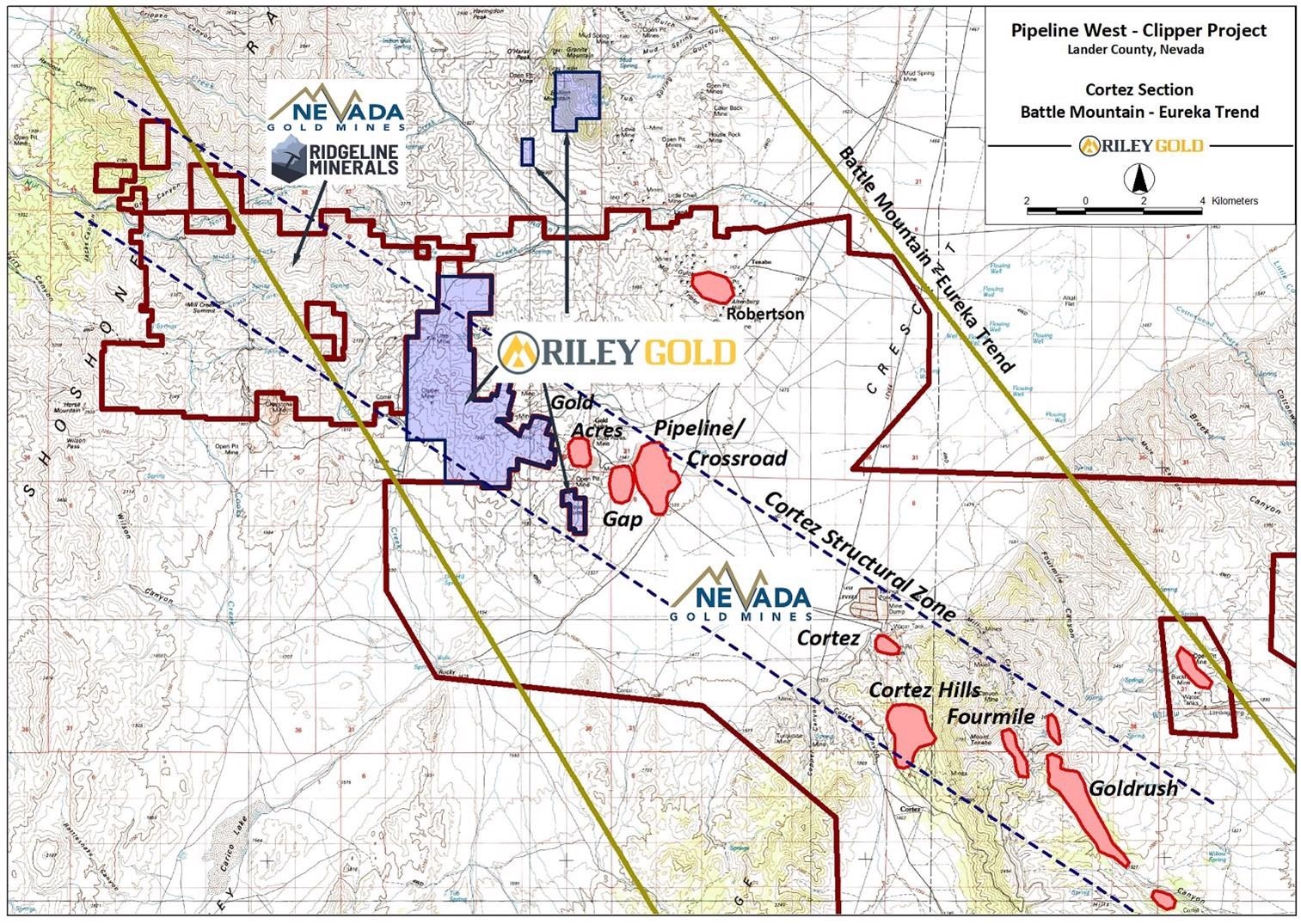Reviewed by Alex SmithApr 29 2022
Riley Gold Corp. announced that a revised examination of various sets of geophysical and soil geochemical information at its Pipeline West/Clipper Gold Project (“PWC”) in Lander County, Nevada, has gained new, potentially promising drill target regions capable of carrying a massive Carlin-type gold deposit.
 Location of PWC, within the Cortez Structural Zone (Leonardson, 2010). Image Credit: Riley Gold Corp.
Location of PWC, within the Cortez Structural Zone (Leonardson, 2010). Image Credit: Riley Gold Corp.
Riley Gold’s land portfolio covers roughly 24.7 km2 of unpatented mining rights and patented properties in the Battle Mountain—Eureka Trend’s Cortez area.
Nevada Gold Mines LLC (“NGM”), a consortium between Barrick Gold Corp. and Newmont Corporation, almost fully surrounds PWC. PWC’s eastern limit is within 1,000 m of NGM’s Pipeline/Gap Mine and only 600 meters from NGM’s Gold Acres open pit, where a glimpse into the Roberts Mountains Thrust’s lower plate carbonates outcrops.
PWC borders Ridgeline Minerals’ Swift project on the north and west, which is susceptible to an earn-in agreement among Ridgeline and NGM under which NGM can receive up to a 70% interest by spending $30 million (up to a 75% interest by preparing debt finance for Ridgeline’s part of infrastructure costs).
Along with a 3-kilometer trend, PWC has very promising Carlin-type gold potential. These goals are backed up by:
- Past drilling (revealing Devonian Wenban host rocks are within 300–500 m of the surface)
- Open gold-in-soil anomalies
- Geophysics:
- Ground and Air Magnetic Surveys
- Gravity
- CSAMT
PWC, when seen as a whole, represents an intriguing promise for future discovery.
Relatively shallow target depths combined with overlapping geophysical and geochemical anomalies provide exciting targets for our first round of drilling at PWC.
Charles Sulfrian, Exploration Manager, Riley Gold Corp.
Sulfrian was also a former Barrick Sr. Geologist. “The target model is similar to discoveries at the Nevada Gold Mines Joint Venture, Cortez Complex, operated by Barrick Gold Corp.,” he says.
Soil Sampling
The prior operators’ soil and lithic sampling left open-ended gold in soil aberrations inside the red ellipse’s target area. An extra soil sample will be required to fill up the gaps left by the previous sampling. Locally anomalous pathfinder elements include thulium, mercury, antimony and local arsenic.
Previous deep drilling had been carefully focused, mostly offsetting known minerals from earlier drilling. Riley Gold has identified a target region that has yet to be drilled.
Geophysical Modeling:
Mr. Chet Lide, VP & Managing Geophysicist of Zonge International near Reno, Nevada, reviewed and modeled geophysical data with the Riley Gold team.
Numerous overlapping anomalies have been discovered in the Lower Plate of the Roberts Mountain Thrust system, based on new and extensive analysis of ground and aero-magnetic data, gravity, and Controlled Source Audio-Frequency Magneto-Telluric (CSAMT) surveys by previous operators. Previous drilling at PWC revealed that Devonian Wenban units could be found there.
In addition, the previous drilling intersected gold mineralization in the Lower Plate strata, with gold concentrations as high as 2.594 grams per ton. Large swaths of PWC, on the other hand, stay undrilled and ripe for exploration. Drill sites at or above 500 m depth are also available in a large section of these locations.
A gradient like this is shown within the red ellipse. The Gold Acres pit is also situated on the crest of a steep incline. Drill targets for estimated structural junctions associated with soil geochemical and geophysical anomalies make compelling drill targets.